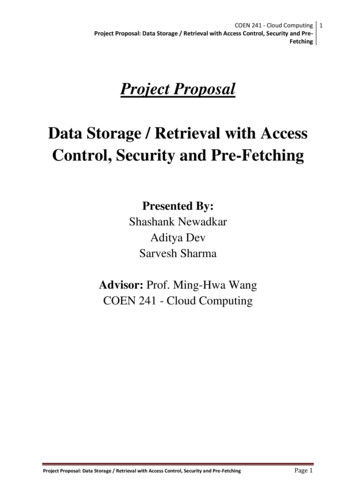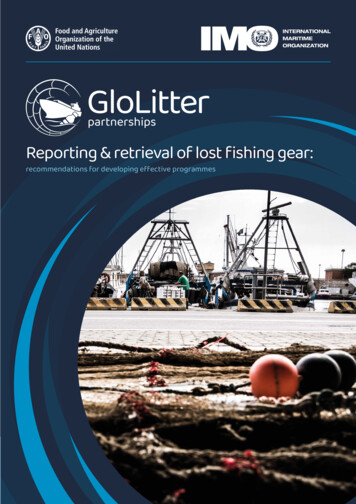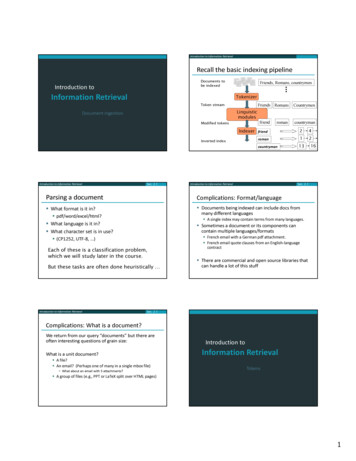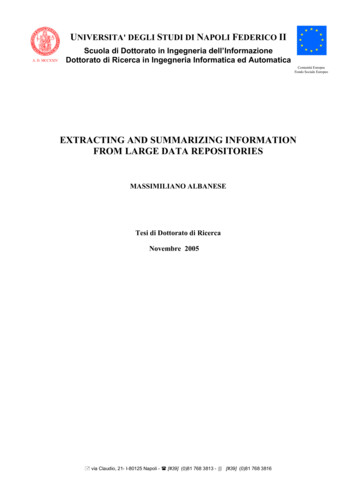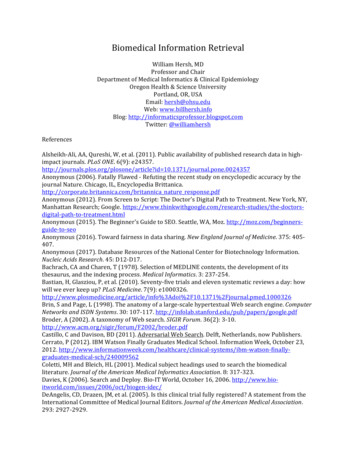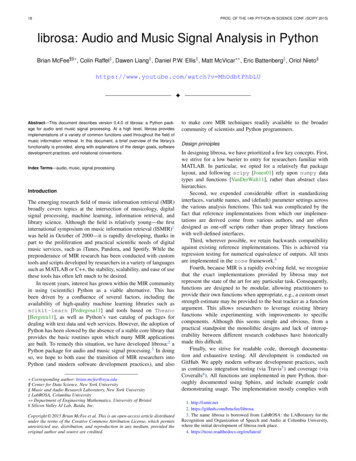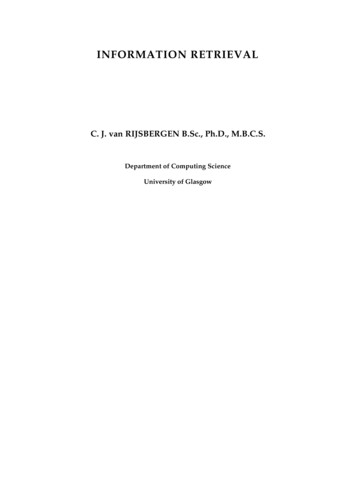
Transcription
INFORMATION RETRIEVALC. J. van RIJSBERGEN B.Sc., Ph.D., M.B.C.S.Department of Computing ScienceUniversity of Glasgow
PREFACE TO THE SECOND EDITIONThe major change in the second edition of this book is the addition of a new chapter onprobabilistic retrieval.This chapter has been included because I think this is one of themost interesting and active areas of research in information retrieval.There are still manyproblems to be solved so I hope that this particular chapter will be of some help to thosewho want to advance the state of knowledge in this area. All the other chapters have beenupdated by including some of the more recent work on the topics covered. In preparing thisnew edition I have benefited from discussions with Bruce Croft, David Harper, StephenRobertson and Karen Sparck Jones. I am grateful to the University of Cambridge ComputerLaboratory for providing me with the facilities for carrying out the work.Finally, I amindebted to the Royal Society for supporting me on their Scientific Information ResearchFellowship.PREFACE TO THE FIRST EDITIONThe material of this book is aimed at advanced undergraduate information (or computer)science students, postgraduate library science students, and research workers in the field ofIR.Some of the chapters, particularly Chapter 6* , make simple use of a little advancedmathematics.However, the necessary mathematical tools can be easily mastered fromnumerous mathematical texts that now exist and, in any case, references have been givenwhere the mathematics occur.I had to face the problem of balancing clarity of exposition with density of references.Iwas tempted to give large numbers of references but was afraid they would have destroyedthe continuity of the text.I have tried to steer a middle course and not compete with theAnnual Review of Information Science and Technology.*This is Chapter 7 in the second edition.
Normally one is encouraged to cite only works that have been published in some readilyaccessible form, such as a book or periodical. Unfortunately, much of the interesting workin IR is contained in technical reports and Ph.D. theses.For example, most the work doneon the SMART system at Cornell is available only in reports.Luckily many of these arenow available through the National Technical Information Service (U.S.) and UniversityMicrofilms (U.K.). I have not avoided using these sources although if the same material isaccessible more readily in some other form I have given it preference.I should like to acknowledge my considerable debt to many people and institutions thathave helped me.Let me say first that they are responsible for many of the ideas in thisbook but that only I wish to be held responsible. My greatest debt is to Karen Sparck Joneswho taught me to research information retrieval as an experimental science. Nick Jardineand Robin Sibson taught me about the theory of automatic classification.is responsible for forcing me to think about evaluation.Cyril CleverdonMike Keen helped by providingdata. Gerry Salton has influenced my thinking about IR considerably, mainly through hispublished work. Ken Moody had the knack of bailing me out when the going was roughand encouraging me to continue experimenting. Juliet Gundry is responsible for making thetext more readable and clear. Bruce Croft, who read the final draft, made many usefulcomments.Ness Barry takes all the credit for preparing the manuscript.Finally, I amgrateful to the Office of Scientific and Technical Information for funding most of the earlyexperimental work on which the book is based; to the Kings College Research Centre forproviding me with an environment in which I could think, and to the Department ofInformation Science at Monash University for providing me with the facilities for writing.C.J.v.R.
ContentsOne: INTRODUCTION.1The structure of the book.2Outline.3Information retrieval.3An information retrieval system.4IR in perspective.5Effectiveness and efficiency.6Bibliographic remarks.7References.7Two: AUTOMATIC TEXT ANALYSIS.10Luhn's ideas.10Generating document representatives - conflation.12Indexing.13Index term weighting.13Probabilistic indexing.15Discrimination and/or representation.17Automatic keyword classification.17Three: AUTOMATIC CLASSIFICATION.23Measures of association.24The cluster hypothesis.29Single-link.35The appropriateness of stratified hierarchic cluster methods.36Single-link and the minimum spanning tree.38Implication of classification methods.38Conclusion.40Bibliographic remarks.40References.41Four: FILE STRUCTURES.46Introduction.46
Logical or physical organisation and data independence.46A language for describing file structures.47Basic terminology.47Trees.58Scatter storage or hash addressing.61Bibliographic remarks.63References.64Five: SEARCH STRATEGIES.68Introduction.68Boolean search.68Matching functions.69Serial search.70Cluster representatives.70Cluster-based retrieval.73Interactive search formulation.74Feedback.75Bibliographic remarks.77References.77Six: PROBABILISTIC RETRIEVAL.5Introduction.5Estimation or calculation of relevance.6Basic probabilistic model*.7Form of retrieval function.9The index terms are not independent.10Selecting the best dependence trees.12Estimation of parameters.14Recapitulation.16The curse of dimensionality.17Computational details.17An alternative way of using the dependence tree (Association Hypothesis) 19Discrimination power of an index term.20Discrimination gain hypothesis.21
Bibliographic remarks.23Seven: EVALUATION.5Introduction.5Relevance.6Precision and recall, and others.7Averaging techniques.9Interpolation.10Composite measures.12The Swets model.12Foundation.22Presentation of experimental results.28Significance tests.29Bibliographic remarks.30References.31Eight: THE FUTURE.35Future research.35Automatic classification.35File structures.36Search strategies.36Simulation.36Evaluation.37Content analysis.37Future developments.38
OneINTRODUCTIONInformation retrieval is a wide, often loosely-defined term but in these pages I shall be concerned onlywith automatic information retrieval systems. Automatic as opposed to manual and information asopposed to data or fact. Unfortunately the word information can be very misleading. In the context ofinformation retrieval (IR), information, in the technical meaning given in Shannon's theory ofcommunication, is not readily measured (Shannon and Weaver1 ). In fact, in many cases one canadequately describe the kind of retrieval by simply substituting 'document' for 'information'.Nevertheless, 'information retrieval' has become accepted as a description of the kind of work publishedby Cleverdon, Salton, Sparck Jones, Lancaster and others. A perfectly straightforward definition alongthese lines is given by Lancaster2 : 'Information retrieval is the term conventionally, though somewhatinaccurately, applied to the type of activity discussed in this volume. An information retrieval systemdoes not inform (i.e. change the knowledge of) the user on the subject of his inquiry. It merely informson the existence (or non-existence) and whereabouts of documents relating to his request.' Thisspecifically excludes Question-Answering systems as typified by Winograd3 and those described byMinsky4 . It also excludes data retrieval systems such as used by, say, the stock exchange for on-linequotations.To make clear the difference between data retrieval (DR) and information retrieval (IR), I have listedin Table 1.1 some of the distinguishing properties of data and information retrieval. OneTable 1.1 DATA RETRIEVAL OR INFORMATION RETRIEVAL?Data Retrieval (DR) Information Retrieval (IR)MatchingExact matchPartial match, best ry languageArtificialNaturalQuery specificationCompleteIncompleteItems wantedMatchingRelevantError responseSensitiveInsensitivemay want to criticise this dichotomy on the grounds that the boundary between the two is a vague one.And so it is, but it is a useful one in that it illustrates the range of complexity associated with each modeof retrieval.Let us now take each item in the table in turn and look at it more closely. In data retrieval we arenormally looking for an exact match, that is, we are checking to see whether an item is or is not presentin the file. In information retrieval this may sometimes be of interest but more generally we want to findthose items which partially match the request and then select from those a few of the best matching ones.The inference used in data retrieval is of the simple deductive kind, that is, aRb and bRc then aRc. Ininformation retrieval it is far more common to use inductive inference; relations are only specified witha degree of certainty or uncertainty and hence our confidence in the inference is variable. This
2Information retrievaldistinction leads one to describe data retrieval as deterministic but information retrieval as probabilistic.Frequently Bayes' Theorem is invoked to carry out inferences in IR, but in DR probabilities do not enterinto the processing.Another distinction can be made in terms of classifications that are likely to be useful. In DR we aremost likely to be interested in a monothetic classification, that is, one with classes defined by objectspossessing attributes both necessary and sufficient to belong to a class. In IR such a classification is onthe whole not very useful, in fact more often a polythetic classification is what is wanted. In such aclassification each individual in a class will possess only a proportion of all the attributes possessed by allthe members of that class. Hence no attribute is necessary nor sufficient for membership to a class.The query language for DR will generally be of the artificial kind, one with restricted syntax andvocabulary, in IR we prefer to use natural language although there are some notable exceptions. In DRthe query is generally a complete specification of what is wanted, in IR it is invariably incomplete. Thislast difference arises partly from the fact that in IR we are searching for relevant documents as opposedto exactly matching items. The extent of the match in IR is assumed to indicate the likelihood of therelevance of that item. One simple consequence of this difference is that DR is more sensitive to error inthe sense that, an error in matching will not retrieve the wanted item which implies a total failure of thesystem. In IR small errors in matching generally do not affect performance of the system significantly.Many automatic information retrieval systems are experimental. I only make occasional reference tooperational systems. Experimental IR is mainly carried on in a 'laboratory' situation whereas operationalsystems are commercial systems which charge for the service they provide. Naturally the two systems areevaluated differently. The 'real world' IR systems are evaluated in terms of 'user satisfaction' and theprice the user is willing to pay for their services. Experimental IR systems are evaluated by comparingthe retrieval experiments with standards specially constructed for the purpose. I believe that a book onexperimental information retrieval, covering the design and evaluation of retrieval systems from a pointof view which is independent of any particular system, will be a great help to other workers in the fieldand indeed is long overdue.Many of the techniques I shall discuss will not have proved themselves incontrovertibly superior to allother techniques, but they have promise and their promise will only be realised when they areunderstood. Information about new techniques has been so scattered through the literature that to findout about them you need to be an expert before you begin to look. I hope that I will be able to take thereader to the point where he will have little trouble in implementing some of the new techniques. Also,that some people will then go on to experiment with them, and generate new, convincing evidence oftheir efficiency and effectiveness.My aim throughout has been to give a complete coverage of the more important ideas current invarious special areas of information retrieval. Inevitably some ideas have been elaborated at the expenseof others. In particular, emphasis is placed on the use of automatic classification techniques and rigorousmethods of measurement of effectiveness. On the other hand, automatic content analysis is given only asuperficial coverage. The reasons are straightforward, firstly the material reflects my own bias, andsecondly, no adequate coverage of the first two topics has been given before whereas automatic contentanalysis has been documented very well elsewhere. A subsidiary reason for emphasising automaticclassification is that little appears to be known or understood about it in the context of IR so thatresearch workers are loath to experiment with it.The structure of the bookThe introduction presents some basic background material, demarcates the subject and discusses looselysome of the problems in IR. The chapters that follow cover topics in the order in which I would thinkabout them were I about to design an experimental IR system. They begin by describing the generationof machine representations for the information, and then move on to an explanation of the logicalstructures that may be arrived at by clustering. There are numerous methods for representing thesestructures in the computer, or in other words, there is a choice of file structures to represent the logicalstructure, so these are outlined next. Once the information has been stored in this way we are able tosearch it, hence a discussion of search strategies follows. The chapter on probabilistic retrieval is anattempt to create a formal model for certain kinds of search strategies. Lastly, in an experimentalsituation all of the above will have been futile unless the results of retrieval can be evaluated. Therefore a
Introduction3large chapter is devoted to ways of measuring the effectiveness of retrieval. In the final chapter I haveindulged in a little speculation about the possibilities for IR in the next decade.The two major chapters are those dealing with automatic classification and evaluation. I have tried towrite them in such a way that each can be read independently of the rest of the book (although I do notrecommend this for the non-specialist).OutlineChapter 2: Automatic Text Analysis - contains a straightforward discussion of how the text of adocument is represented inside a computer. This is a superficial chapter but I think it is adequate in thecontext of this book.Chapter 3: Automatic Classification - looks at automatic classification methods in general and thentakes a deeper look at the use of these methods in information retrieval.Chapter 4: File Structures - here we try and discuss file structures from the point of view of someoneprimarily interested in information retrieval.Chapter 5: Search Strategies - gives an account of some search strategies when applied to documentcollections structured in different ways. It also discusses the use of feedback.Chapter 6: Probabilistic Retrieval - describes a formal model for enhancing retrieval effectiveness byusing sample information about the frequency of occurrence and co-occurrence of index terms in therelevant and non-relevant documents.Chapter 7: Evaluation - here I give a traditional view of the measurement of effectiveness followed byan explanation of some of the more promising attempts at improving the art. I also attempt to providefoundations for a theory of evaluation.Chapter 8: The Future - contains some speculation about the future of IR and tries to pinpoint someareas of research where further work is desperately needed.Information retrievalSince the 1940s the problem of information storage and retrieval has attracted increasing attention. It issimply stated: we have vast amounts of information to which accurate and speedy access is becomingever more difficult. One effect of this is that relevant information gets ignored since it is neveruncovered, which in turn leads to much duplication of work and effort. With the advent of computers, agreat deal of thought has been given to using them to provide rapid and intelligent retrieval systems. Inlibraries, many of which certainly have an information storage and retrieval problem, some of the moremundane tasks, such as cataloguing and general administration, have successfully been taken over bycomputers. However, the problem of effective retrieval remains largely unsolved.In principle, information storage and retrieval is simple. Suppose there is a store of documents and aperson (user of the store) formulates a question (request or query) to which the answer is a set ofdocuments satisfying the information need expressed by his question. He can obtain the set by readingall the documents in the store, retaining the relevant documents and discarding all the others. In a sense,this constitutes 'perfect' retrieval. This solution is obviously impracticable. A user either does not havethe time or does not wish to spend the time reading the entire document collection, apart from the factthat it may be physically impossible for him to do so.When high speed computers became available for non-numerical work, many thought that acomputer would be able to 'read' an entire document collection to extract the relevant documents. Itsoon became apparent that using the natural language text of a document not only caused input andstorage problems (it still does) but also left unsolved the intellectual problem of characterising thedocument content. It is conceivable that future hardware developments may make natural languageinput and storage more feasible. But automatic characterisation in which the software attempts toduplicate the human process of 'reading' is a very sticky problem indeed. More specifically, 'reading'involves attempting to extract information, both syntactic and semantic, from the text and using it todecide whether each document is relevant or not to a particular request. The difficulty is not only
4Information retrievalknowing how to extract the information but also how to use it to decide relevance. The comparativelyslow progress of modern linguistics on the semantic front and the conspicuous failure of machinetranslation (Bar-Hillel5 ) show that these problems are largely unsolved.The reader will have noticed that already, the idea of 'relevance' has slipped into the discussion. It isthis notion which is at the centre of information retrieval. The purpose of an automatic retrieval strategyis to retrieve all the relevant documents at the same time retrieving as few of the non-relevant as possible.When the characterisation of a document is worked out, it should be such that when the document itrepresents is relevant to a query, it will enable the document to be retrieved in response to that query.Human indexers have traditionally characterised documents in this way when assigning index terms todocuments. The indexer attempts to anticipate the kind of index terms a user would employ to retrieveeach document whose content he is about to describe. Implicitly he is constructing queries for which thedocument is relevant. When the indexing is done automatically it is assumed that by pushing the text ofa document or query through the same automatic analysis, the output will be a representation of thecontent, and if the document is relevant to the query, a computational procedure will show this.Intellectually it is possible for a human to establish the relevance of a document to a query. For acomputer to do this we need to construct a model within which relevance decisions can be quantified. Itis interesting to note that most research in information retrieval can be shown to have been concernedwith different aspects of such a model.An information retrieval systemLet me illustrate by means of a black box what a typical IR system would look like. The diagram showsthree components: input, processor and output. Such a trichotomy may seem a little trite, but thecomponents constitute a convenient set of pegs upon which to hang a discussion.Starting with the input side of things. The main problem here is to obtain a representation of eachdocument and query suitable for a computer to use. Let me emphasise that most computer-basedretrieval systems store only a representation of the document (or query) which means that the text of adocument is lost once it has been processed for the purpose of generating its representation. A documentrepresentative could, for example, be a list of extracted words considered to be significant. Rather thanhave the computer process the natural language, an alternative approach is to have an artificial languagewithin which all queries and documents can be formulated. igure 1.1. A typical IR systemis some evidence to show that this can be effective (Barber et al.6 ). Of course it presupposes that a user iswilling to be taught to express his information need in the language.
Introduction5When the retrieval system is on-line, it is possible for the user to change his request during one searchsession in the light of a sample retrieval, thereby, it is hoped, improving the subsequent retrieval run.Such a procedure is commonly referred to as feedback. An example of a sophisticated on-line retrievalsystem is the MEDLINE system (McCarn and Leiter7 ). I think it is fair to say that it will be only a shorttime before all retrieval systems will be on-line.Secondly, the processor, that part of the retrieval system concerned with the retrieval process. Theprocess may involve structuring the information in some appropriate way, such as classifying it. It willalso involve performing the actual retrieval function, that is, executing the search strategy in response toa query. In the diagram, the documents have been placed in a separate box to emphasise the fact thatthey are not just input but can be used during the retrieval process in such a way that their structure ismore correctly seen as part of the retrieval process.Finally, we come to the output, which is usually a set of c
PREFACE TO THE SECOND EDITION The major change in the second edition of this book is the addition of a new chapter on probabilistic retrieval. This chapter has been included because I think this is one of the most interesting and active areas of research in information retrieval. There are still many


